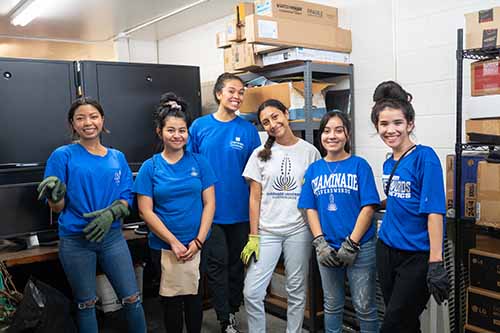Chaminade students teach Jarrett Middle School students about economics
Standing in front of 13 William P. Jarrett Middle School students, Chopper Correia ’27, Brayden Braga ’27 and Roselyn Macias ’26 started their lesson by asking the students what they knew—if anything at their age—about economics. Some boisterously screamed out “money,” while others yelled “business.”
“In preparation, we’ve outlined a lesson plan,” said Macias, studying her notes before the class began. “This is my first visit here so I’m not sure what to expect.”
It was the second for Correia and Braga, both freshmen Silversword baseball players and Business Administration majors. “We’ll cover such topics as price control and budgeting,” Correia and Braga echoed. “And we’ll play a little game with them because they can easily associate with playing games.”
Turning to the class, Braga posed a second question: Who has ever heard the terms micro and macro economics? One student asked aloud, “Does it have something to do with money and budget? ” Another fired back with “small and big.” Right, Braga responded to “small and big,” then simplified the terms by explaining that microeconomics and macroeconomics are related, but separate approaches to studying the economy.
Macias took Braga’s explanation even further by expanding the subject to cover the definition of price control, price ceiling and price floor. “Price control comes in two forms,” the sophomore Business Marketing major said. “A price ceiling keeps a price from rising above a certain level—the ceiling. And a price floor keeps a price from falling below a certain level—the floor.”

Braga, Correia and Macias are all participating in Chaminade’s Office of Service Learning and Community Engagement program, which aims to empower students to define and deepen their classroom learning experience through impactful need-based community engagement rooted in Marianist and Native Hawaiian values.
“Our vision is to foster a collective sense of place through investment in community partnerships, service learning process and pedagogy, and a commitment to serving others,” said Mitch Steffey, Chaminade’s Associate Director of Service Learning and Community Engagement Service. “We envision a campus culture that embraces service and service learning as a valuable community-focused vehicle toward personal growth.”
The benefits of service learning extend to both the students and the communities they serve. For students, service learning allows them to apply classroom theories and concepts to tangible, real-world situations. This hands-on experience enhances their understanding of academic material and fosters critical thinking skills. Students also often acquire a diverse set of skills, including communication, teamwork, problem-solving and leadership. These skills are transferable to various professional and personal contexts, contributing to their overall development.
Meanwhile, the benefits to the community are many. First and foremost, service learning projects are designed to address specific community needs. Whether it’s tutoring, environmental initiatives or healthcare support, students contribute directly to ameliorating the well-being of the community. Secondly, universities and communities can build long-term, mutually beneficial partnerships through service learning programs. These collaborations promote ongoing support for community initiatives and foster a sense of shared responsibility.
“We also have a similar program with Palolo Elementary School,” said Jacob Escuza ’25, a student worker who acts as the Chaminade University liaison between Jarrett Middle School and Palolo Elementary School. “The Palolo program, though, is more of a one-on-one tutorial session with the kids.”
Steffey distinguishes the difference between community service and learning service. Citing an example of the latter, he uses a biology student who could go out in the lo‘i kalo (taro patch) to test the waters to see why one part of the patch produces more kalo than another.
“He/she can test if there’s too much acid in the water,” Steffey explained. “So, we’re going to the community to fulfill a need with the expertise that we already have through our professors, courses and classrooms.
“You don’t have that at beach cleanup,” Steffey continued. “The cleanup is good for the community, but there isn’t much learning being done.”
Jarrett Middle School students certainly learned about budgeting when Correia asked them to take a piece a paper out and pencil, and then pointed to a list on a whiteboard that included such budget line items as rent, food, water, video games, savings, candy, toys, furniture, toiletry and bike. Each was assigned a value from one to three points.
“You have 10 points or consider it the amount of money you make,” Correia instructed. “Now, choose the items you want until you reach 10 points and no more. And that will be your budget.”
The majority of the students prioritized rent and food, followed by video games, candy and bike. “I’m going to need a bike to get to work,” one student rationalized for adding the necessary transportation to the top of his priority list. “And I’m going have to eat, but I’m going to need a place to eat.”










